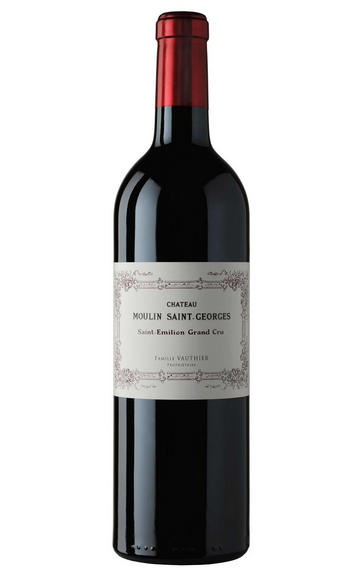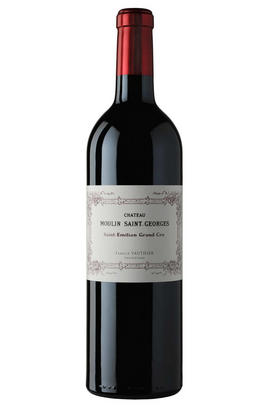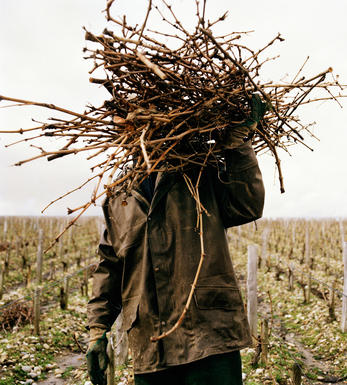
2014 Château Moulin Saint-Georges, St Emilion, Bordeaux

Critics reviews
Neal Martin - Wine Advocate - eRobertParker.com #218 Apr 2015
Jancis Robinson MW - jancisrobinson.com - Apr 2015
About this WINE

Chateau Moulin Saint-Georges
Château Moulin St Georges has been referred to as a junior version of Château Ausone as it is owned by the same proprietors, the Vauthier family. Its 17.3 acres of vineyards are located between those of Ausone and La Gaffelière and are well-sited on a south-west facing slope, known as the Pavie slope. The vineyards are planted with Merlot (66%), the rest (34%) Cabernet Franc and Cabernet Sauvignon.
The vines are expertly cultivated by Vauthier who firmly believes that a wine's quality is first and foremost a function of the vines and the fruit they bear. Consequently, yields are kept deliberately low and the grapes exclusively hand-harvested. Winemaking takes place in temperature-controlled, stainless steel tanks and the wine is then matured in 100% new oak barriques for 15-20 months. The wines are bottled unfiltered.

St Émilion
St Émilion is one of Bordeaux's largest producing appellations, producing more wine than Listrac, Moulis, St Estèphe, Pauillac, St Julien and Margaux put together. St Emilion has been producing wine for longer than the Médoc but its lack of accessibility to Bordeaux's port and market-restricted exports to mainland Europe meant the region initially did not enjoy the commercial success that funded the great châteaux of the Left Bank.
St Émilion itself is the prettiest of Bordeaux's wine towns, perched on top of the steep limestone slopes upon which many of the region's finest vineyards are situated. However, more than half of the appellation's vineyards lie on the plain between the town and the Dordogne River on sandy, alluvial soils with a sprinkling of gravel.
Further diversity is added by a small, complex gravel bed to the north-east of the region on the border with Pomerol. Atypically for St Émilion, this allows Cabernet Franc and, to a lesser extent, Cabernet Sauvignon to prosper and defines the personality of the great wines such as Ch. Cheval Blanc.
In the early 1990s there was an explosion of experimentation and evolution, leading to the rise of the garagistes, producers of deeply-concentrated wines made in very small quantities and offered at high prices. The appellation is also surrounded by four satellite appellations, Montagne, Lussac, Puisseguin and St. Georges, which enjoy a family similarity but not the complexity of the best wines.
St Émilion was first officially classified in 1954, and is the most meritocratic classification system in Bordeaux, as it is regularly amended. The most recent revision of the classification was in 2012

Merlot
The most widely planted grape in Bordeaux and a grape that has been on a relentless expansion drive throughout the world in the last decade. Merlot is adaptable to most soils and is relatively simple to cultivate. It is a vigorous naturally high yielding grape that requires savage pruning - over-cropped Merlot-based wines are dilute and bland. It is also vital to pick at optimum ripeness as Merlot can quickly lose its varietal characteristics if harvested overripe.
In St.Emilion and Pomerol it withstands the moist clay rich soils far better than Cabernet grapes, and at it best produces opulently rich, plummy clarets with succulent fruitcake-like nuances. Le Pin, Pétrus and Clinet are examples of hedonistically rich Merlot wines at their very best. It also plays a key supporting role in filling out the middle palate of the Cabernet-dominated wines of the Médoc and Graves.
Merlot is now grown in virtually all wine growing countries and is particularly successful in California, Chile and Northern Italy.


Buying options
Add to wishlist
Description
This wine is normally a leading contender for our great-value category, and, assuming the price is right this year, it will be again in 2014. Slightly restrained on the nose, it is rewarding on the palate. Nice cherry juice and well-judged tannin make for a really rewarding palate. A crowd-pleasing wine, and atypical of all that is good about St Emilion. This property is back to its best this year.
wine at a glance
Delivery and quality guarantee